Does Coffee Have Terroir and How Should It Be Assessed?
Abstract
1. Introduction
2. Factors Affecting the Terroir Assessment
2.1. Coffee Sensory Experience and Analysis
2.2. How Does the Brew Method Affect the Coffee Terroir Experience?
2.3. How Does the Coffee Particle Size Affect the Experience of the Coffee Terroir?
2.4. The Effects of Roasting on the Coffee Terroir Experience
3. The Effect of Harvest and Post-Harvest Processing Methods on Terroir
4. Environmental and Management Factors Affecting Coffee Terroir
4.1. Temperatures—Altitude and Shading
4.2. Moisture Relations—Rainfall and Irrigation
4.3. Species and Varietal Effects
4.4. Soil and Fertility Management
4.5. Other Environmental and Management Factors Affecting Terroir
5. Biochemical Markers and Terroir
6. Conclusions
Author Contributions
Funding
Data Availability Statement
Acknowledgments
Conflicts of Interest
References
- Decazy, F.; Avelino, J.; Guyot, B.; Perriot, J.J.; Pineda, C.; Cilas, C. Quality of different Honduran coffees in relation to several environments. J. Food Sci. 2003, 68, 2356–2361. [Google Scholar] [CrossRef]
- Vaudour, E.; Costantini, E.; Jones, G.V.; Mocali, S. An overview of the recent approaches to terroir functional modelling, footprinting and zoning. Soil 2015, 1, 287–312. [Google Scholar] [CrossRef]
- Anesi, A.; Stocchero, M.; Dal Santo, S.; Commisso, M.; Zenoni, S.; Ceoldo, S.; Tornielli, G.B.; Siebert, T.E.; Herderich, M.; Pezzotti, M.; et al. Towards a scientific interpretation of the terroir concept: Plasticity of the grape berry metabolome. BMC Plant Biol. 2015, 15, 191. [Google Scholar] [CrossRef] [PubMed]
- Van Leeuwen, C.; Barbe, J.-C.; Darriet, P.; Geffroy, O.; Gomes, E.; Guillaumie, S.; Helwi, P.; Laboyrie, J.; Lytra, G.; Le Menn, N.; et al. Recent advancements in understanding the terroir effect on aromas in grapes and wines. Oeno One 2020, 54, 985–1006. [Google Scholar] [CrossRef]
- Scholz, M.; Kitzberger, C.S.G.; Prudencio, S.H.; Silva, R. The typicity of coffees from different terroirs determined by groups of physico-chemical and sensory variables and multiple factor analysis. Food Res. Int. 2018, 114, 72–80. [Google Scholar] [CrossRef] [PubMed]
- Silva, S.D.A.; de Queiroz, D.M.; Ferreira, W.P.; Correa, P.C.; Rufino, J.L. Mapping the potential beverage quality of coffee produced in the Zona da Mata, Minas Gerais, Brazil. J. Sci. Food Agric. 2016, 96, 3098–3108. [Google Scholar] [CrossRef]
- International Organisation of Vine and Wine. Definition of Vitivinicultural “Terroir”. Resolution OIV/VITI 333/2010; International Organisation of Vine and Wine: Paris, France, 2010. [Google Scholar]
- Souza Gonzaga, L.; Capone, D.L.; Bastian, S.E.P.; Jeffery, D.W. Defining wine typicity: Sensory characterisation and consumer perspectives. Aust. J. Grape Wine Res. 2021, 27, 246–256. [Google Scholar] [CrossRef]
- Conley, J.; Wilson, B. Coffee terroir: Cupping description profiles and their impact upon prices in Central American coffees. GeoJournal 2020, 85, 67–79. [Google Scholar] [CrossRef]
- Seninde, D.R.; Chambers, E. Coffee Flavor: A Review. Beverages 2020, 6, 44. [Google Scholar] [CrossRef]
- Hu, G.L.; Peng, X.R.; Gao, Y.; Huang, Y.J.; Li, X.; Su, H.G.; Qiu, M.H. Effect of roasting degree of coffee beans on sensory evaluation: Research from the perspective of major chemical ingredients. Food Chem. 2020, 331, 127329. [Google Scholar] [CrossRef]
- Cordoba, N.; Fernandez-Alduenda, M.; Moreno, F.L.; Ruiz, Y. Coffee extraction: A review of parameters and their influence on the physicochemical characteristics and flavour of coffee brews. Trends Food Sci. Technol. 2020, 96, 45–60. [Google Scholar] [CrossRef]
- Haile, M.; Kang, W.H. The Role of Microbes in Coffee Fermentation and Their Impact on Coffee Quality. J. Food Qual. 2019, 2019, 4836709. [Google Scholar] [CrossRef]
- Hameed, A.; Hussain, S.A.; Ijaz, M.U.; Ullah, S.; Pasha, I.; Suleria, H.A.R. Farm to Consumer: Factors Affecting the Organoleptic Characteristics of Coffee. II: Postharvest Processing Factors. Compr. Rev. Food. Sci. Food Saf. 2018, 17, 1184–1237. [Google Scholar] [CrossRef] [PubMed]
- Xu, L.; Lao, F.; Xu, Z.; Wang, X.; Chen, F.; Liao, X.; Chen, A.; Yang, S. Use of liquid chromatography quadrupole time-of-flight mass spectrometry and metabolomic approach to discriminate coffee brewed by different methods. Food Chem. 2019, 286, 106–112. [Google Scholar] [CrossRef] [PubMed]
- Lambot, C.; Herrera, J.C.; Bertrand, B.; Sadeghian, S.; Benavides, P.; Gaitán, A. Cultivating coffee quality-terroir and agro-Ecosystem. In The Craft and Science of Coffee; Academic Press: Cambridge, MA, USA, 2017; pp. 17–49. [Google Scholar]
- Thomas, E.; Puget, S.; Valentin, D.; Songer, P. Sensory evaluation—Profiling and preferences. In The Craft and Science of Coffee; Academic Press: Cambridge, MA, USA, 2017; pp. 419–456. [Google Scholar]
- Specialty Coffee Association. Coffee Standards; Specialty Coffee Association: Chelmsford, UK, 2018. [Google Scholar]
- Di Donfrancesco, B.; Guzman, N.G.; Chambers, E. Comparison of results from cupping and descriptive sensory analysis of Colombian brewed coffee. J. Sens. Stud. 2014, 29, 301–311. [Google Scholar] [CrossRef]
- Sensory Lexicon Advisory Group. World Coffee Research Sensory Lexicon, 2nd ed.; World Coffee Research: College Station, TX, USA, 2017; p. 54. [Google Scholar]
- Steen, I.; Waehrens, S.S.; Petersen, M.A.; Munchow, M.; Bredie, W.L. Influence of serving temperature on flavour perception and release of Bourbon Caturra coffee. Food Chem. 2017, 219, 61–68. [Google Scholar] [CrossRef]
- Barahona, I.; Sanmiguel Jaimes, E.M.; Yang, J.B. Sensory attributes of coffee beverages and their relation to price and package information: A case study of Colombian customers’ preferences. Food Sci. Nutr. 2020, 8, 1173–1186. [Google Scholar] [CrossRef]
- Cordoba, N.; Pataquiva, L.; Osorio, C.; Moreno, F.L.M.; Ruiz, R.Y. Effect of grinding, extraction time and type of coffee on the physicochemical and flavour characteristics of cold brew coffee. Sci. Rep. 2019, 9, 12. [Google Scholar] [CrossRef]
- Angeloni, G.; Guerrini, L.; Masella, P.; Innocenti, M.; Bellumori, M.; Parenti, A. Characterization and comparison of cold brew and cold drip coffee extraction methods. J. Sci. Food Agric. 2019, 99, 391–399. [Google Scholar] [CrossRef]
- ISO 18794:2018(E); Coffee—Sensory Analysis—Vocabulary. ISO: Geneva, Switzerland, 2018.
- ISO 6668:2008(E); Green Coffee—Preparation of Samples for Use in Sensory Analysis. ISO: Geneva, Switzerland, 2017.
- Bressanello, D.; Liberto, E.; Cordero, C.; Rubiolo, P.; Pellegrino, G.; Ruosi, M.R.; Bicchi, C. Coffee aroma: Chemometric comparison of the chemical information provided by three different samplings combined with GC-MS to describe the sensory properties in cup. Food Chem. 2017, 214, 218–226. [Google Scholar] [CrossRef]
- Bolivar, J.T.C.; Pérez, W.R.; Salazar, J.C.S.; Espinosa, C.M.O.; Cano, G.A.V. Minority compounds and sensory analysis evaluation of Coffea arabica var. caturra cultivated in three different altitudinal ranges. Acta Agron. 2017, 66, 221–227. [Google Scholar] [CrossRef]
- Cafe Imports Department of Sensory Analysis. Analytic Cupping Score Card; Cafe Imports: Berlin, Germany, 2017. [Google Scholar]
- Sunarharum, W.B. The Compositional Basis of Coffee Flavour. Ph.D. Thesis, The University of Queensland, Brisbane, Australia, 2016. [Google Scholar]
- Silveira, A.S.; Pinheiro, A.C.T.; Ferreira, W.P.M.; Silva, L.J.; Rufino, J.L.S.; Sakiyama, N.S. Sensory analysis of specialty coffee from different environmental conditions in the region of matas de minas, minas gerais, Brazil. Rev. Ceres 2016, 63, 436–443. [Google Scholar] [CrossRef]
- Chambers, E.; Sanchez, K.; Phan, U.X.T.; Miller, R.; Civille, G.V.; Di Donfrancesco, B. Development of a “living” lexicon for descriptive sensory analysis of brewed coffee. J. Sens. Stud. 2016, 31, 465–480. [Google Scholar] [CrossRef]
- Evangelista, S.R.; Silva, C.F.; Miguel, M.; Cordeiro, C.D.; Pinheiro, A.C.M.; Duarte, W.F.; Schwan, R.F. Improvement of coffee beverage quality by using selected yeasts strains during the fermentation in dry process. Food Res. Int. 2014, 61, 183–195. [Google Scholar] [CrossRef]
- Hetzel, A. Fine Robusta Standards and Protocols v1.1; Uganda Coffee Development Authority: Kampala, Uganda, 2011. [Google Scholar]
- Borsato, D.; Pina, M.V.R.; Spacino, K.R.; Scholz, M.B.D.; Androcioli Filho, A. Application of artificial neural networks in the geographical identification of coffee samples. Eur. Food Res. Technol. 2011, 233, 533–543. [Google Scholar] [CrossRef]
- Pérez-Martínez, M.; Sopelana, P.; De Peña, M.P.; Cid, C. Effects of refrigeration and oxygen on the coffee brew composition. Eur. Food Res. Technol. 2008, 227, 1633–1640. [Google Scholar] [CrossRef]
- Brazilian Coffee Industry Association. Recommended Quality Standard and Best Practices Manufacture of Roasted Grain Coffee and Roasted and Ground Coffee; Brazilian Coffee Industry Association: Varginha, Brazil, 2004. [Google Scholar]
- Maeztu, L.; Andueza, S.; Ibanez, C.; de Pena, M.P.; Bello, J.; Cid, C. Multivariate methods for characterization and classification of espresso coffees from different botanical varieties and types of roast by foam, taste, and mouthfeel. J. Agric. Food Chem. 2001, 49, 4743–4747. [Google Scholar] [CrossRef]
- Grupo de Avaliação do Café. FO-055 GAC Report Model; Grupo de Avaliação do Café: Sao Paulo, Brazil, 2000; p. 3. [Google Scholar]
- Alliance for Coffee Excellence. Cup of Excellence Forms; Alliance for Coffee Excellence: Portland, OR, USA, 2002. [Google Scholar]
- Caporaso, N.; Genovese, A.; Canela, M.D.; Civitella, A.; Sacchi, R. Neapolitan coffee brew chemical analysis in comparison to espresso, moka and American brews. Food Res. Int. 2014, 61, 152–160. [Google Scholar] [CrossRef]
- Sanchez, K.; Chambers, E. How does product preparation affect sensory properties? An example with coffee. J. Sens. Stud. 2015, 30, 499–511. [Google Scholar] [CrossRef]
- Gloess, A.N.; Schönbächler, B.; Klopprogge, B.; D’Ambrosio, L.; Chatelain, K.; Bongartz, A.; Strittmatter, A.; Rast, M.; Yeretzian, C. Comparison of nine common coffee extraction methods: Instrumental and sensory analysis. Eur. Food Res. Technol. 2013, 236, 607–627. [Google Scholar] [CrossRef]
- Nebesny, E.; Budryn, G. Evaluation of sensory attributes of coffee brews from robusta coffee roasted under different conditions. Eur. Food Res. Technol. 2006, 224, 159–165. [Google Scholar] [CrossRef]
- Marin, K.; Požrl, T.; Zlatić, E.; Plestenjak, A. A New Aroma Index to Determine the Aroma Quality of Roasted and Ground Coffee During Storage. Food Technol. Biotechnol. 2008, 46, 442–447. [Google Scholar]
- Specialty Coffee Association of America. SCAA Standard. Golden Cup; Specialty Coffee Association of America: Irvine, CA, USA, 2015. [Google Scholar]
- Lingle, T.R.; Menon, S.N. Cupping and Grading—Discovering Character and Quality. In The Craft and Science of Coffee; Academic Press: Cambridge, MA, USA, 2017; pp. 181–203. [Google Scholar]
- Pereira, L.L.; Cardoso, W.S.; Guarconi, R.C.; da Fonseca, A.F.A.; Moreira, T.R.; ten Caten, C.S. The consistency in the sensory analysis of coffees using Q-graders. Eur. Food Res. Technol. 2017, 243, 1545–1554. [Google Scholar] [CrossRef]
- Pereira, L.L.; Guarconi, R.C.; de Souza, G.S.; Brioschi, D.; Moreira, T.R.; ten Caten, C.S. Propositions on the Optimal Number of Q-Graders and R-Graders. J. Food Qual. 2018, 7, 3285452. [Google Scholar] [CrossRef]
- Kulapichitr, F.; Borompichaichartkul, C.; Suppavorasatit, I.; Cadwallader, K.R. Impact of drying process on chemical composition and key aroma components of Arabica coffee. Food Chem. 2019, 291, 49–58. [Google Scholar] [CrossRef] [PubMed]
- WCE Rules and Regulations Committee. 2020 World Cup Tasters Championship Official Rules and Regulations; World Coffee Events: Dublin, Ireland, 2020. [Google Scholar]
- Abrahao, S.A.; Pereira, R.; de Sousa, R.V.; Lima, A.R.; Crema, G.P.; Barros, B.S. Influence of Coffee Brew in Metabolic Syndrome and Type 2 Diabetes. Plant Food Hum. Nutr. 2013, 68, 184–189. [Google Scholar] [CrossRef]
- Batali, M.E.; Frost, S.C.; Lebrilla, C.B.; Ristenpart, W.D.; Guinard, J.X. Sensory and monosaccharide analysis of drip brew coffee fractions versus brewing time. J. Sci. Food Agric. 2020, 100, 2953–2962. [Google Scholar] [CrossRef]
- Cammerer, B.; Kroh, L.W. Antioxidant activity of coffee brews. Eur. Food Res. Technol. 2006, 223, 469–474. [Google Scholar] [CrossRef]
- Technical Standards Committee. Guidelines for Brewing with a Two Cup Pour-Over Brewer. In SCAA Best Practice; Specialty Coffee Association of America: Irvine, CA, USA, 2016. [Google Scholar]
- Fibrianto, K.; Febryana, Y.R.; Wulandari, E.S. Effect of brewing technique and particle size of the ground coffee on sensory profiling of brewed Dampit robusta coffee. In Proceedings of the International Conference on Green Agro-Industry and Bioeconomy, Batu City, Indonesia, 24–25 October 2017; IOP Conference Series-Earth and Environmental Science. IOP Publishing Ltd.: Bristol, UK, 2018; Volume 131. [Google Scholar]
- Fujioka, K.; Shibamoto, T. Chlorogenic acid and caffeine contents in various commercial brewed coffees. Food Chem. 2008, 106, 217–221. [Google Scholar] [CrossRef]
- Han, J.; Kim, M.K.; Lee, K.G. Furan Levels and Sensory Profiles of Commercial Coffee Products Under Various Handling Conditions. J. Food Sci. 2017, 82, 2759–2766. [Google Scholar] [CrossRef]
- López-Galilea, I.; Fournier, N.; Cid, C.; Guichard, E. Changes in headspace volatile concentrations of coffee brews caused by the roasting process and the brewing procedure. J. Agric. Food Chem. 2006, 54, 8560–8566. [Google Scholar] [CrossRef] [PubMed]
- Ludwig, I.A.; Sanchez, L.; Caemmerer, B.; Kroh, L.W.; De Pena, M.P.; Cid, C. Extraction of coffee antioxidants: Impact of brewing time and method. Food Res. Int. 2012, 48, 57–64. [Google Scholar] [CrossRef]
- Niseteo, T.; Komes, D.; Belščak-Cvitanović, A.; Horžić, D.; Budeč, M. Bioactive composition and antioxidant potential of different commonly consumed coffee brews affected by their preparation technique and milk addition. Food Chem. 2012, 134, 1870–1877. [Google Scholar] [CrossRef] [PubMed]
- Rendón, M.Y.; De Jesus Garcia Salva, T.; Bragagnolo, N. Impact of chemical changes on the sensory characteristics of coffee beans during storage. Food Chem. 2014, 147, 279–286. [Google Scholar] [CrossRef]
- Seo, H.S.; Lee, M.; Jung, Y.J.; Hwang, I. A novel method of descriptive analysis on hot brewed coffee: Time scanning descriptive analysis. Eur. Food Res. Technol. 2009, 228, 931–938. [Google Scholar] [CrossRef]
- Scholz, M.B.D.S.; Silva, J.V.N.D.; Figueiredo, V.R.G.D.; Kitzberger, C.S.G. Sensory atributes and physico-chemical characteristics of the coffee beverage from the IAPAR cultivars. Coffee Sci. 2013, 8, 6–16. [Google Scholar] [CrossRef]
- Sittipod, S.; Schwartz, E.; Paravisini, L.; Peterson, D.G. Identification of flavor modulating compounds that positively impact coffee quality. Food Chem. 2019, 301, 125250. [Google Scholar] [CrossRef]
- Tfouni, S.A.V.; Serrate, C.S.; Leme, F.M.; Camargo, M.C.R.; Teles, C.R.A.; Cipolli, K.; Furlani, R.P.Z. Polycyclic aromatic hydrocarbons in coffee brew: Influence of roasting and brewing procedures in two Coffea cultivars. LWT Food Sci. Technol. 2013, 50, 526–530. [Google Scholar] [CrossRef]
- Alves, R.C.; Almeida, I.M.C.; Casal, S.; Oliveira, M. Isoflavones in Coffee: Influence of Species, Roast Degree, and Brewing Method. J. Agric. Food Chem. 2010, 58, 3002–3007. [Google Scholar] [CrossRef]
- Golden Bean Australia. Competition entry guidelines golden bean coffee roasters competition and conference. In Proceedings of the Golden Bean Coffee Roasters Competition and Conference, Port Macquarie, Australia, 25–29 October 2019. [Google Scholar]
- WCE Rules and Regulations Committee. 2020 World Barista Championship Rules and Regulations; World Coffee Events: Dublin, Ireland, 2019. [Google Scholar]
- Kim, S.Y.; Kang, B.S. A colorimetric sensor array-based classification of coffees. Sens. Actuators B Chem. 2018, 275, 277–283. [Google Scholar] [CrossRef]
- Royal Queensland Show. 2020 Royal Queensland Coffee Awards; The Royal National Agricultural and Industrial Association of Queensland (RNA): Bowen Hills, Australia, 2020; p. 9. [Google Scholar]
- Maeztu, L.; Sanz, C.; Andueza, S.; De Pena, M.P.; Bello, J.; Cid, C. Characterization of espresso coffee aroma by static headspace GC-MS and sensory flavor profile. J. Agric. Food Chem. 2001, 49, 5437–5444. [Google Scholar] [CrossRef] [PubMed]
- Navarini, L.; Ferrari, M.; Liverani, F.S.; Liggieri, L.; Ravera, F. Dynamic tensiometric characterization of espresso coffee beverage. Food Hydrocoll. 2004, 18, 387–393. [Google Scholar] [CrossRef]
- Fadhil, R.; Nurba, D. Comparison of Gayo Arabica coffee taste sensory scoring system between Eckenrode and Fuzzy-Eckenrode methods. IOP Conf. Ser. Earth Environ. Sci. 2019, 365, 012040. [Google Scholar] [CrossRef]
- Pérez-Martínez, M.; Caemmerer, B.; De Peña, M.P.; Concepción, C.; Kroh, L.W. Influence of brewing method and acidity regulators on the antioxidant capacity of coffee brews. J. Agric. Food Chem. 2010, 58, 2958–2965. [Google Scholar] [CrossRef]
- Parenti, A.; Guerrini, L.; Masella, P.; Spinelli, S.; Calamai, L.; Spugnoli, P. Comparison of espresso coffee brewing techniques. J. Food Eng. 2014, 121, 112–117. [Google Scholar] [CrossRef]
- Alves, R.C.; Soares, C.; Casal, S.; Fernandes, J.O.; Oliveira, M. Acrylamide in espresso coffee: Influence of species, roast degree and brew length. Food Chem. 2010, 119, 929–934. [Google Scholar] [CrossRef]
- Bell, L.N.; Wetzel, C.R.; Grand, A.N. Caffeine content in coffee as influenced by grinding and brewing techniques. Food Res. Int. 1996, 29, 785–789. [Google Scholar] [CrossRef]
- Frost, S.C.; Ristenpart, W.D.; Guinard, J.X. Effect of Basket Geometry on the Sensory Quality and Consumer Acceptance of Drip Brewed Coffee. J. Food Sci. 2019, 84, 2297–2312. [Google Scholar] [CrossRef]
- Gniechwitz, D.; Brueckel, B.; Reichardt, N.; Blaut, M.; Steinhart, H.; Bunzel, M. Coffee dietary fiber contents and structural characteristics as influenced by coffee type and technological and brewing procedures. J. Agric. Food Chem. 2007, 55, 11027–11034. [Google Scholar] [CrossRef]
- Lee, S.J.; Kim, M.K.; Lee, K.-G. Effect of reversed coffee grinding and roasting process on physicochemical properties including volatile compound profiles. Innov. Food Sci. Emerg. Technol. 2017, 44, 97–102. [Google Scholar] [CrossRef]
- Technical Standards Committee. Guidelines for brewing with a column brewer. In SCAA Best Practice; Specialty Coffee Association of America: Irvine, CA, USA, 2016. [Google Scholar]
- Technical Standards Committee. Guidelines for brewing with a single cup immersion drippe. In SCAA Best Practice; Specialty Coffee Association of America: Irvine, CA, USA, 2016. [Google Scholar]
- Technical Standards Committee. Guidelines for brewing with a three cup french press. In SCAA Best Practice; Specialty Coffee Association of America: Irvine, CA, USA, 2016. [Google Scholar]
- Technical Standards Committee. SCAA Protocols. Cupping Specialty Coffee; Specialty Coffee Association of America: Irvine, CA, USA, 2015; p. 10. [Google Scholar]
- Smith, J. Coffee Landscapes: Specialty Coffee, Terroir, and Traceability in Costa Rica. Cult. Agric. Food Environ. 2018, 40, 36–44. [Google Scholar] [CrossRef]
- AZoM. com. Particle Size—US Sieve Series and Tyler Mesh Size Equivalents; AZoNetwork UK Ltd.: Manchester, UK, 2002. [Google Scholar]
- Moeenfard, M.; Silva, J.A.; Borges, N.; Santos, A.; Alves, A. Diterpenes in espresso coffee: Impact of preparation parameters. Eur. Food Res. Technol. 2015, 240, 763–773. [Google Scholar] [CrossRef]
- Laukaleja, I.; Kruma, Z. Influence of the roasting process on bioactive compounds and aroma profile in specialty coffee: A review. In Proceedings of the Baltic Conference on Food Science and Technology and North and East European Congress on Food, Jelgava, Latvia, 2–3 May 2019. [Google Scholar]
- Münchow, M.; Alstrup, J.; Steen, I.; Giacalone, D. Roasting Conditions and Coffee Flavor: A Multi-Study Empirical Investigation. Beverages 2020, 6, 29. [Google Scholar] [CrossRef]
- Toledo, P.R.A.B.; Pezza, L.; Pezza, H.R.; Toci, A.T. Relationship Between the Different Aspects Related to Coffee Quality and Their Volatile Compounds. Compr. Rev. Food. Sci. Food Saf. 2016, 15, 705–719. [Google Scholar] [CrossRef]
- Stephenson, T. The Curious Barista’s Guide to Coffee; Ryland Peters & Small: London, UK, 2019. [Google Scholar]
- Gonzalez-Rios, O.; Suarez-Quiroz, M.L.; Boulanger, R.; Barel, M.; Guyot, B.; Guiraud, J.P.; Schorr-Galindo, S. Impact of “ecological” post-harvest processing on coffee aroma: II. Roasted coffee. J. Food Compos. Anal. 2007, 20, 297–307. [Google Scholar] [CrossRef]
- Batista, L.R.; de Souza, S.M.C.; e Batista, C.F.S.; Schwan, R.F. Coffee: Types and production. In Encyclopedia of Food and Health; Academic Press: Cambridge, MA, USA, 2016; pp. 244–251. [Google Scholar]
- Carmo, K.B.; Carmo, J.C.B.; Krause, M.R.; Moreli, A.P.; Lo Monaco, P.A.V. Quality of arabic coffee under different processing systems, drying methods and alti-tudes. Biosci. J. 2020, 36, 1116–1125. [Google Scholar] [CrossRef]
- Junqueira, A.C.D.; Pereira, G.V.D.; Medina, J.D.C.; Alvear, M.C.R.; Rosero, R.; Neto, D.P.D.; Enriquez, H.G.; Soccol, C.R. First description of bacterial and fungal communities in Colombian coffee beans fermentation analysed using Illumina-based amplicon sequencing. Sci. Rep. 2019, 9, 8794. [Google Scholar] [CrossRef]
- Partida-Sedas, J.G.; Ferreiro, M.N.M.; Vazquez-Oderiz, M.L.; Romero-Rodriguez, M.A.; Perez-Portilla, E. Influence of the postharvest processing of the “Garnica” coffee variety on the sensory characteristics and overall acceptance of the beverage. J. Sens. Stud. 2019, 34, e12502. [Google Scholar] [CrossRef]
- Sanz-Uribe, J.R.; Yusianto; Menon, S.N.; Peñuela, A.; Oliveros, C.; Husson, J.; Brando, C.; Rodriguez, A. Postharvest processing—Revealing the green bean. In The Craft and Science of Coffee; Academic Press: Cambridge, MA, USA, 2017; pp. 51–79. [Google Scholar]
- Pereira, L.L.; Guarçoni, R.C.; Pinheiro, P.F.; Osório, V.M.; Pinheiro, C.A.; Moreira, T.R.; ten Caten, C.S. New propositions about coffee wet processing: Chemical and sensory perspectives. Food Chem. 2020, 310, 125943. [Google Scholar] [CrossRef]
- Bote, A.D.; Vos, J. Tree management and environmental conditions affect coffee (Coffea arabica L.) bean quality. NJAS Wagening. J. Life Sci. 2021, 83, 39–46. [Google Scholar] [CrossRef]
- Eira, M.T.S.; Silva, E.A.; De Castro, R.D.; Dussert, S.; Walters, C.; Bewley, J.D.; Hilhorst, H.W.M. Coffee seed physiology. Braz. J. Plant Physiol. 2006, 18, 149–163. [Google Scholar] [CrossRef]
- Schmitt, L.; Perfecto, I. Who gives a flux? Synchronous flowering of Coffea arabica accelerates leaf litter decomposition. Ecosphere 2020, 11, e03186. [Google Scholar] [CrossRef]
- Vaast, P.; Bertrand, B.; Perriot, J.-J.; Guyot, B.; Génard, M. Fruit thinning and shade improve bean characteristics and beverage quality of coffee (Coffea arabica L.) under optimal conditions. J. Sci. Food Agric. 2006, 86, 197–204. [Google Scholar] [CrossRef]
- Avelino, J.; Perriot, J.J.; Guyot, B.; Pineda, C.; Decazy, F.; Cilas, C. Identifying Terroir Coffees in Honduras. Research and Coffee Growing; CIRAD: Montpellier, France, 2002; p. 60. [Google Scholar]
- Oberthur, T.; Laderach, P.; Posada, H.; Fisher, M.J.; Samper, L.F.; Illera, J.; Collet, L.; Moreno, E.; Alarcon, R.; Villegas, A.; et al. Regional relationships between inherent coffee quality and growing environment for denomination of origin labels in Narino and Cauca, Colombia. Food Policy 2011, 36, 783–794. [Google Scholar] [CrossRef]
- Cheng, B.; Furtado, A.; Smyth, H.E.; Henry, R.J. Influence of genotype and environment on coffee quality. Trends Food Sci. Technol. 2016, 57, 20–30. [Google Scholar] [CrossRef]
- Avelino, J.; Barboza, B.; Araya, J.C.; Fonseca, C.; Davrieux, F.; Guyot, B.; Cilas, C. Effects of slope exposure, altitude and yield on coffee quality in two altitude terroirs of Costa Rica, Orosi and Santa Maria de Dota. J. Sci. Food Agric. 2005, 85, 1869–1876. [Google Scholar] [CrossRef]
- Bosselmann, A.S.; Dons, K.; Oberthur, T.; Olsen, C.S.; Raebild, A.; Usma, H. The influence of shade trees on coffee quality in small holder coffee agroforestry systems in Southern Colombia. Agric. Ecosyst. Environ. 2009, 129, 253–260. [Google Scholar] [CrossRef]
- Da Silva, E.A.; Mazzafera, P.; Brunini, O.; Sakai, E.; Arruda, F.B.; Mattoso, L.H.C.; Carvalho, C.R.L.; Pires, R.C.M. The influence of water management and environmental conditions on the chemical composition and beverage quality of coffee beans. Braz. J. Plant Physiol. 2005, 17, 229–238. [Google Scholar] [CrossRef]
- Bertrand, B.; Boulanger, R.; Dussert, S.; Ribeyre, F.; Berthiot, L.; Descroix, F.; Joët, T. Climatic factors directly impact the volatile organic compound fingerprint in green Arabica coffee bean as well as coffee beverage quality. Food Chem. 2012, 135, 2575–2583. [Google Scholar] [CrossRef]
- Geromel, C.; Ferreira, L.P.; Guerreiro, S.M.; Cavalari, A.A.; Pot, D.; Pereira, L.F.; Leroy, T.; Vieira, L.G.; Mazzafera, P.; Marraccini, P. Biochemical and genomic analysis of sucrose metabolism during coffee (Coffea arabica) fruit development. J. Exp. Bot. 2006, 57, 3243–3258. [Google Scholar] [CrossRef]
- Muschler, R.G. Shade improves coffee quality in a sub-optimal coffee-zone of Costa Rica. Agrofor. Syst. 2001, 51, 131–139. [Google Scholar] [CrossRef]
- Piato, K.; Lefort, F.; Subia, C.; Caicedo, C.; Calderon, D.; Pico, J.; Norgrove, L. Effects of shade trees on robusta coffee growth, yield and quality. A meta-analysis. Agron. Sustain. Dev. 2020, 40, 38. [Google Scholar] [CrossRef]
- Beer, J. Advantages, disadvantages and desirable characteristics of shade trees for coffee, cacao and tea. Agrofor. Syst. 1987, 5, 3–13. [Google Scholar] [CrossRef]
- DaMatta, F.M.; Ramalho, J.D.C. Impacts of drought and temperature stress on coffee physiology and production: A review. Braz. J. Plant Physiol. 2006, 18, 55–81. [Google Scholar] [CrossRef]
- Kath, J.; Byrareddy, V.M.; Mushtaq, S.; Craparo, A.; Porcel, M. Temperature and rainfall impacts on robusta coffee bean characteristics. Clim. Risk Manag. 2021, 32, 100281. [Google Scholar] [CrossRef]
- Carr, M.K.V. The water relations and irrigation requirements of coffee. Exp. Agric. 2001, 37, 1–36. [Google Scholar] [CrossRef]
- Taniwaki, M.H.; Teixeira, A.A.; Teixeira, A.R.R.; Copetti, M.V.; Iamanaka, B.T. Ochratoxigenic fungi and ochratoxin A in defective coffee beans. Food Res. Int. 2014, 61, 161–166. [Google Scholar] [CrossRef]
- Aguilar, P.; Ribeyre, F.; Escarraman, A.; Bastide, P.; Berthiot, L. Sensory profiles of coffee in the Dominican Republic are linked to the terroirs. Cah. Agric. 2012, 21, 169–178. [Google Scholar] [CrossRef]
- Herrera, J.C.; Lambot, C. The coffee tree—Genetic diversity and origin. In The Craft and Science of Coffee; Academic Press: Cambridge, MA, USA, 2017; pp. 1–16. [Google Scholar]
- World Coffee Research. Arabica Coffee Varieties; World Coffee Research: Portland, OR, USA, 2018; p. 72. [Google Scholar]
- Teixeira, A.L.; Rocha, R.B.; Espindula, M.C.; Ramalho, A.R.; Vieira, J.R.; Alves, E.A.; Lunz, A.M.P.; Souza, F.D.; Costa, J.N.M.; Fernandes, C.D. Amazonian Robustas—New Coffea canephora coffee cultivars for the Western Brazilian Amazon. Crop Breed. Appl. Biotechnol. 2020, 20. [Google Scholar] [CrossRef]
- Morales-Ramos, V.; Escamilla-Prado, E.; Ruiz-Carbajal, R.A.; Perez-Sato, J.A.; Velazquez-Morales, J.A.; Servin-Juarez, R. On the soil-bean-cup relationships in Coffea arabica L. J. Sci. Food Agric. 2020, 100, 5434–5441. [Google Scholar] [CrossRef]
- Abebe, Y.; Juergen, B.; Endashaw, B.; Kitessa, H.; Heiner, G. The role of soil nutrient ratios in coffee quality: Their influence on bean size and cup quality in the natural coffee forest ecosystems of Ethiopia. Afr. J. Agric. Res. 2019, 14, 2090–2103. [Google Scholar] [CrossRef]
- Kopittke, P.M.; Menzies, N.W. A Review of the Use of the Basic Cation Saturation Ratio and the “Ideal” Soil. Soil Sci. Soc. Am. J. 2007, 71, 259–265. [Google Scholar] [CrossRef]
- Mazzafera, P. Mineral nutrition and caffeine content in coffee leaves. Bragantia 1999, 58, 387–391. [Google Scholar] [CrossRef]
- Clemente, J.M.; Martinez, H.E.P.; Alves, L.C.; Finger, F.L.; Cecon, P.R. Effects of nitrogen and potassium on the chemical composition of coffee beans and on beverage quality. Acta Sci. Agron. 2015, 37, 297–305. [Google Scholar] [CrossRef]
- Vinecky, F.; Davrieux, F.; Mera, A.C.; Alves, G.S.C.; Lavagnini, G.; Leroy, T.; Bonnot, F.; Rocha, O.C.; Bartholo, G.F.; Guerra, A.F. Controlled irrigation and nitrogen, phosphorous and potassium fertilization affect the biochemical composition and quality of Arabica coffee beans. J. Agric. Sci. 2017, 155, 902–918. [Google Scholar] [CrossRef]
- Nadaleti, D.H.S.; Vilela, D.J.M.; Carvalho, G.R.; de Mendonça, J.M.A.; Botelho, C.E.; Coelho, L.S.; de Oliveira Fassio, L.; Carvalho, J.P.F.; Fassio, L.; de Minas, E.P. Productivity and sensory quality of arábica coffee in response to pruning type “esqueletamento”. J. Agric. Sci. 2018, 10, 207–216. [Google Scholar] [CrossRef][Green Version]
- Wilson, B.R.; Conley, J.F.; Harris, T.M.; Lafone, F. New terrains of taste: Spatial analysis of price premiums for single origin coffees in Central America. Appl. Geogr. 2012, 35, 499–507. [Google Scholar] [CrossRef]
- Rabelo, M.H.S.; Borem, F.M.; de Lima, R.R.; Alves, A.P.D.; Pinheiro, A.C.M.; Ribeiro, D.E.; dos Santos, C.M.; Pereira, R. Impacts of quaker beans over sensory characteristics and volatile composition of specialty natural coffees. Food Chem. 2021, 342, 128304. [Google Scholar] [CrossRef]
- Cain, C.N.; Haughn, N.J.; Purcell, H.J.; Marney, L.C.; Synovec, R.E.; Thoumsin, C.T.; Jackels, S.C.; Skogerboe, K.J. Analytical Determination of the Severity of Potato Taste Defect in Roasted East African Arabica Coffee. J. Agric. Food Chem. 2021, 69, 2253–2261. [Google Scholar] [CrossRef]
- Wang, C.H.; Sun, J.C.; Lassabliere, B.; Yu, B.; Liu, S.Q. Coffee flavour modification through controlled fermentation of green coffee beans by Saccharomyces cerevisiae and Pichia kluyveri: Part II. Mixed cultures with or without lactic acid bacteria. Food Res. Int. 2020, 136, 109452. [Google Scholar] [CrossRef]
- Aditiawati, P.; Astuti, D.I.; Kriswantoro, J.A.; Khanza, S.M.; Kamarisima; Irifune, T.; Amalia, F.; Fukusaki, E.; Putri, S.P. GC/MS-based metabolic profiling for the evaluation of solid state fermentation to improve quality of Arabica coffee beans. Metabolomics 2020, 16, 57. [Google Scholar] [CrossRef]
- Bressanello, D.; Liberto, E.; Cordero, C.; Sgorbini, B.; Rubiolo, P.; Pellegrino, G.; Ruosi, M.R.; Bicchi, C. Chemometric Modeling of Coffee Sensory Notes through Their Chemical Signatures: Potential and Limits in Defining an Analytical Tool for Quality Control. J. Agric. Food Chem. 2018, 66, 7096–7109. [Google Scholar] [CrossRef] [PubMed]
- Cui, D.D.; Liu, Y.; Chen, Y.P.; Feng, X.; Lu, Y.; Yu, B. Application of SPME-GC-TOFMS, E-nose, and sensory evaluation to investigate the flavor characteristics of Chinese Yunnan coffee at three different conditions (beans, ground powder, and brewed coffee). Flavour Fragr. J. 2020, 35, 541–560. [Google Scholar] [CrossRef]
- Chang, Y.T.; Hsueh, M.C.; Hung, S.P.; Lu, J.M.; Peng, J.H.; Chen, S.F. Prediction of specialty coffee flavors based on near-infrared spectra using machine- and deep-learning methods. J. Sci. Food Agric. 2021, 101, 4705–4714. [Google Scholar] [CrossRef] [PubMed]
- Martins, P.M.M.; Batista, N.N.; Miguel, M.; Simao, J.B.P.; Soares, J.R.; Schwan, R.F. Coffee growing altitude influences the microbiota, chemical compounds and the quality of fermented coffees. Food Res. Int. 2020, 129, 108872. [Google Scholar] [CrossRef]
- Laukaleja, I.; Koppel, K. Aroma active compound perception in differently roasted and brewed coffees by gas chromatography–olfactometry. J. Sens. Stud. 2021, 36, e12708. [Google Scholar] [CrossRef]
- Wang, X.; Wang, Y.; Hu, G.; Hong, D.; Guo, T.; Li, J.; Li, Z.; Qiu, M. Review on factors affecting coffee volatiles: From seed to cup. J. Sci. Food Agric. 2022, 102, 1341–1352. [Google Scholar] [CrossRef]
- Yang, N.; Liu, C.; Liu, X.; Degn, T.K.; Munchow, M.; Fisk, I. Determination of volatile marker compounds of common coffee roast defects. Food Chem. 2016, 211, 206–214. [Google Scholar] [CrossRef]
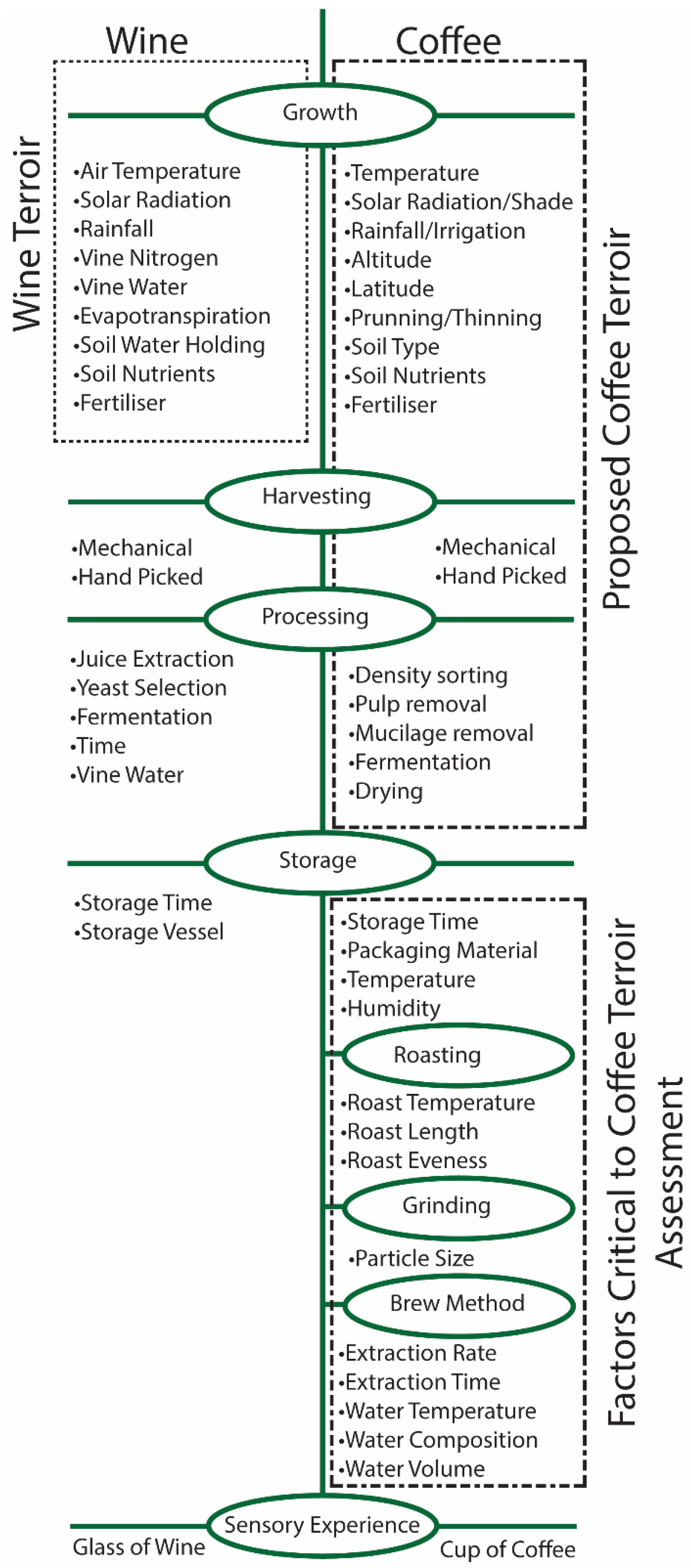
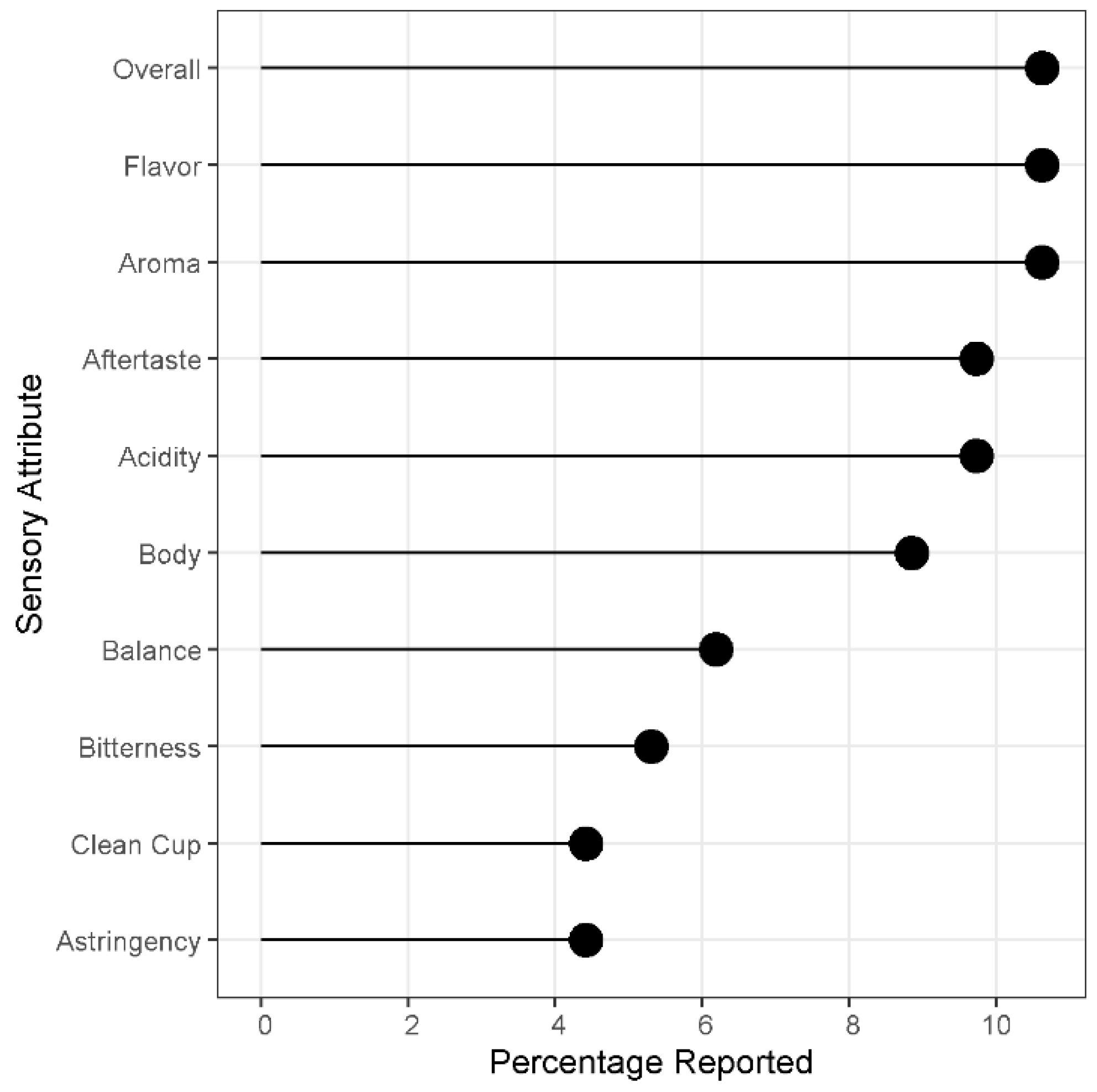
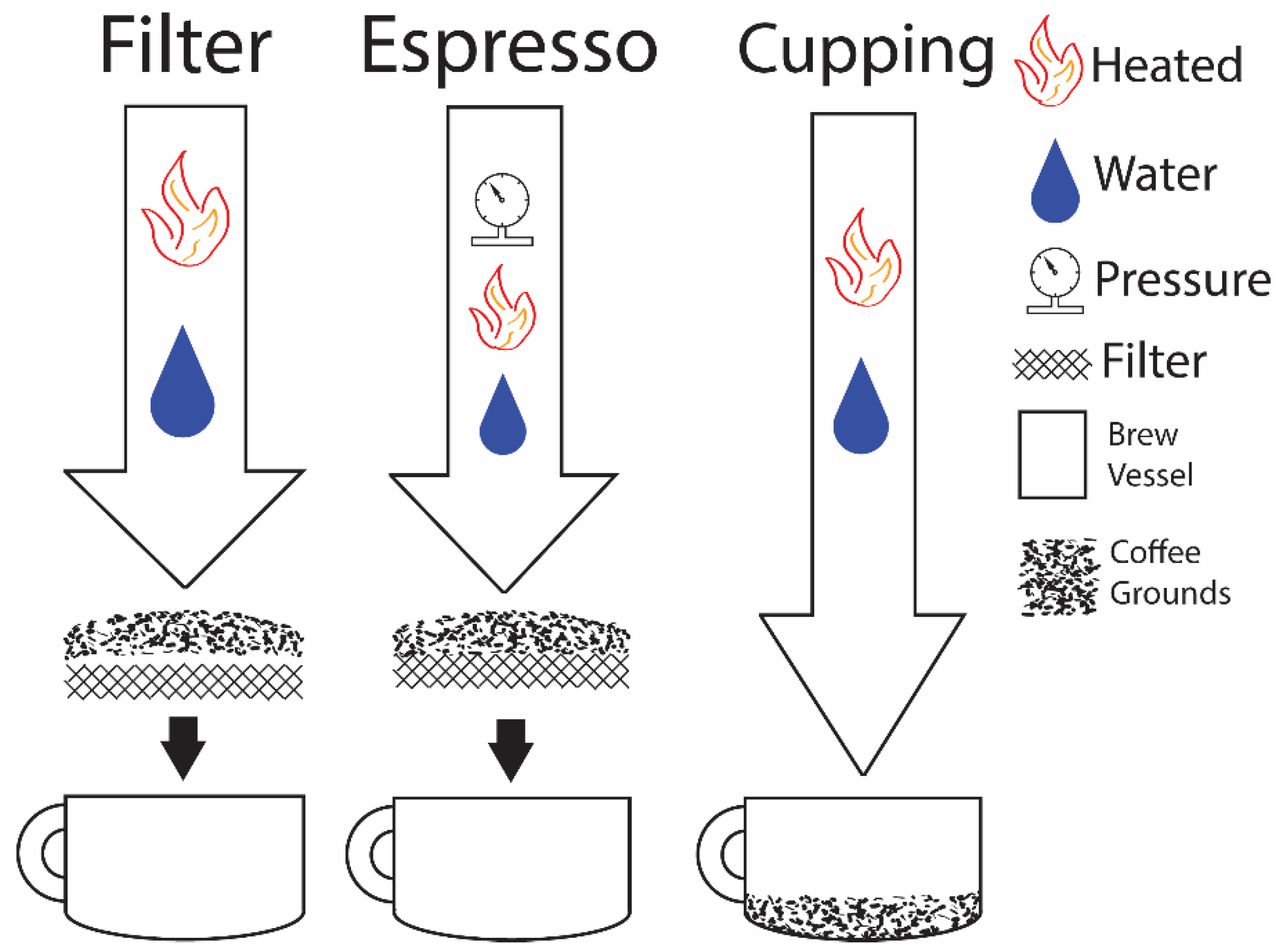
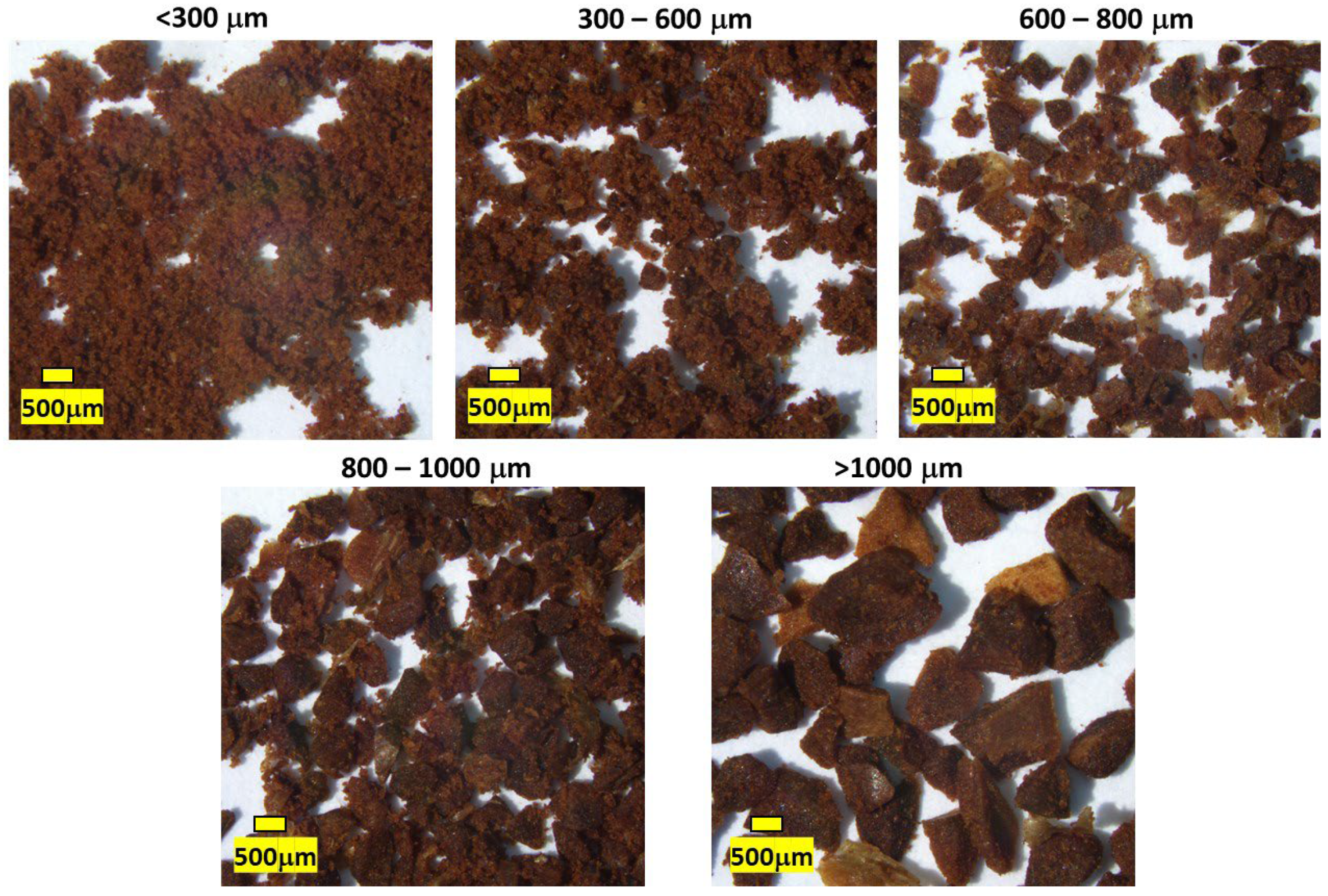
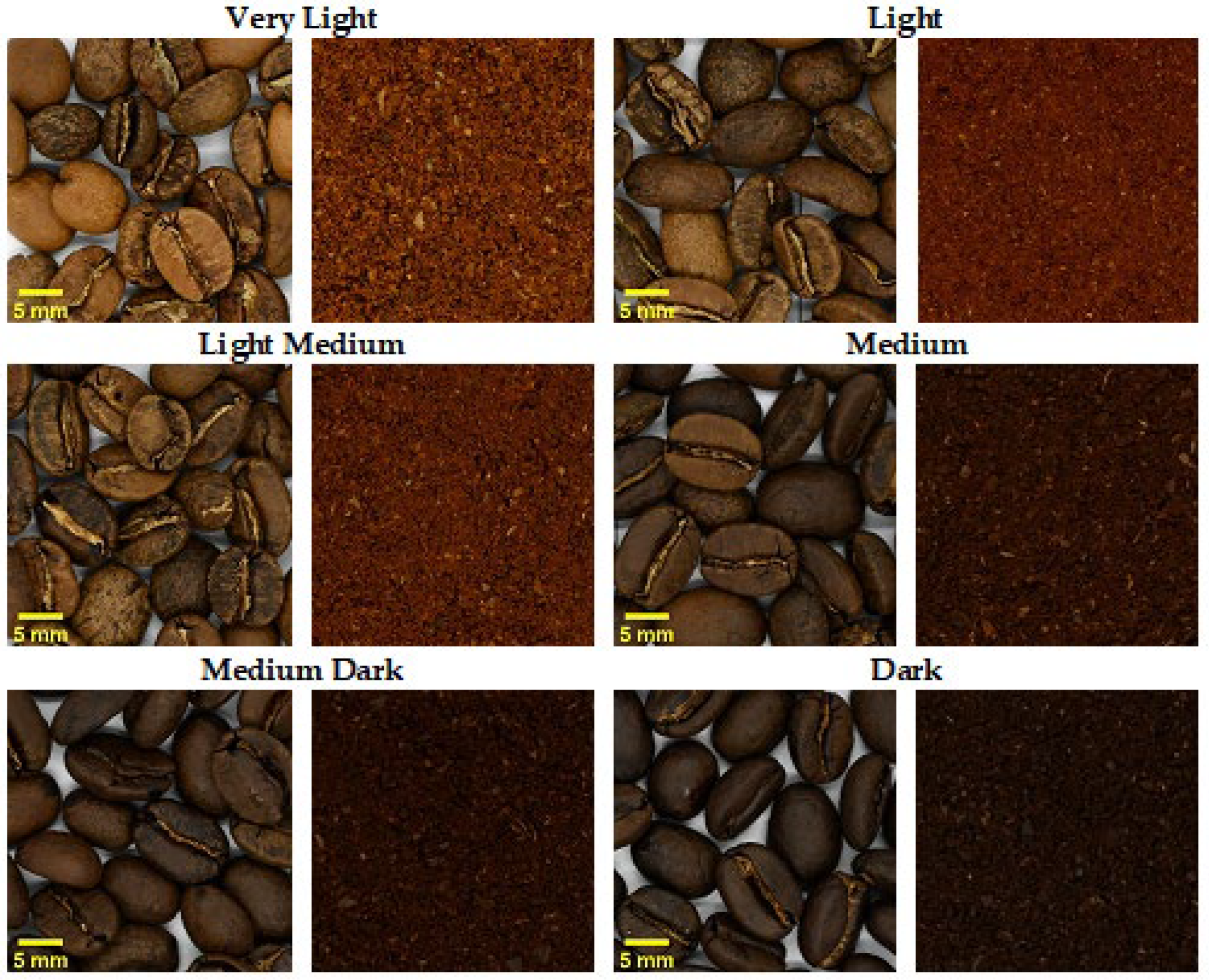

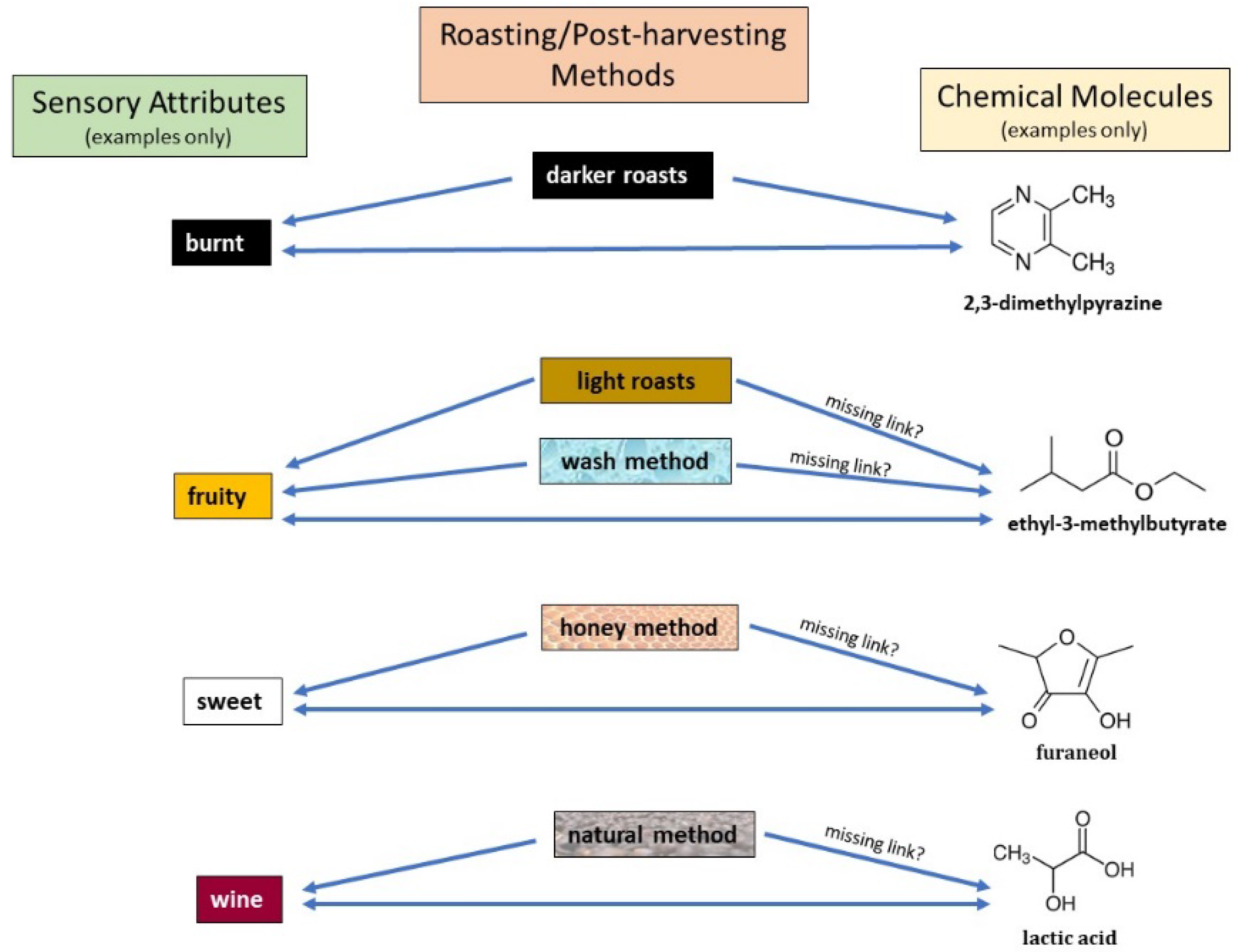
| Brew Method | Cupping 1 | Filter 2 | Espresso 3 |
|---|---|---|---|
| Coffee Grounds (g) | 5–8.25 | 2–210 | 5.5–21 |
| Water (mL) | 100–300 | 100–3800 | 20–100 |
| Water Temperature (°C) | 92—Boiling | 90–100 | 86–97 |
| Brew Time (min) | 3–5 | 2–10 | 10–30 (s) |
| Pressure (bar) | NA | NA | 8.5–19 |
| Water/Coffee ratio | 14.29–20.00 | 7.4–59.0 | 2–18.18 |
| Filter Type | NA | Paper Filter #3, Paper Filter #6, Paper Filter, Metallic Sieve, Ceramic Filter, Metal Filter, Stainless Steel Tea Strainer | Metallic Sieve |
| Arabica | Robusta | |
|---|---|---|
| Altitude (m) | 1000–2100 | 100–1000 |
| Daily Ave Temp (°C) | 18–22 | 22–26 |
| Annual Rainfall (mm) | 1500–2500 | >2000 |
| Sunlight | Partial Shade | Full Sun |
Publisher’s Note: MDPI stays neutral with regard to jurisdictional claims in published maps and institutional affiliations. |
© 2022 by the authors. Licensee MDPI, Basel, Switzerland. This article is an open access article distributed under the terms and conditions of the Creative Commons Attribution (CC BY) license (https://creativecommons.org/licenses/by/4.0/).
Share and Cite
Williams, S.D.; Barkla, B.J.; Rose, T.J.; Liu, L. Does Coffee Have Terroir and How Should It Be Assessed? Foods 2022, 11, 1907. https://doi.org/10.3390/foods11131907
Williams SD, Barkla BJ, Rose TJ, Liu L. Does Coffee Have Terroir and How Should It Be Assessed? Foods. 2022; 11(13):1907. https://doi.org/10.3390/foods11131907
Chicago/Turabian StyleWilliams, Simon D., Bronwyn J. Barkla, Terry J. Rose, and Lei Liu. 2022. "Does Coffee Have Terroir and How Should It Be Assessed?" Foods 11, no. 13: 1907. https://doi.org/10.3390/foods11131907
APA StyleWilliams, S. D., Barkla, B. J., Rose, T. J., & Liu, L. (2022). Does Coffee Have Terroir and How Should It Be Assessed? Foods, 11(13), 1907. https://doi.org/10.3390/foods11131907








